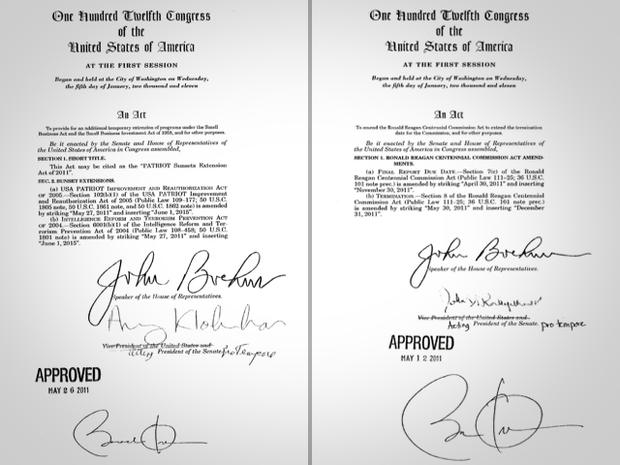Can you tell the autopen from Obama's real signature?
Both of the presidential signatures shown above enacted legislation into law.
One of the signatures is real, actually signed by the hand of President Obama. The other is a facsimile, the work of a mechanical device known as an autopen.
Can you tell the difference?
The signature on the right contains is the real thing. It's on the signature page of a routine measure extending the life of the Ronald Reagan Centennial Commission. President Obama signed it by hand on May 12th. (Also see it here)
The signature on the left - obtained by CBS News from the National Archives and published here for the first time - looks like the real thing, but isn't. It's the work of an autopen, a robotic apparatus used to sign a precise copy of the president's John Hancock. (Also see it here)
For the first time in U.S. history, Mr. Obama authorized the use of such a machine to sign a bill into law. On May 26th, he was 3700 miles away at the G8 Summit in France, up against a midnight deadline to prevent provisions of the Patriot Act from expiring, so he authorized the White House Staff Secretary the use the autopen to sign it.
The problem is - and few proclaim they see a problem - is that the U.S. Constitution makes no provision for the use of a signature machine. Article 1, Section 7 clearly states that if a bill is passed by both the House and Senate, it shall be presented to the president. "If he approve(s) he shall sign it," states the Constitution. There's nothing in the document that suggests a reasonable facsimile affixed by an appliance will do just as well.
The White House circumvented the constitutional requirement citing a 2005 opinion from the Justice Department's Office of Legal Counsel. It concluded that
"...the President need not personally perform the physical act of affixing his signature to a bill he approves and decides to sign in order for the bill to become law."
So in the White House view, it doesn't make a difference that one bill is really signed by the president and the other bears a look-alike signature from a mechanical appliance.
If a machine can sign for the President, could Sasha, too?
Congressman questions Patriot Act "autopen" signature
White House rejects plea for Obama to re-sign bill
Only 21 House members, Republicans all, have raised constitutional concerns about the use of an autopen to sign a bill into law.
"Mr. President, your use of the autopen appears contrary to the Constitution," they wrote in a letter last Friday. They challenge the assertions made in the legal opinion on which the White House bases its use of the autopen to sign legislation.
It's "a debatable issue and could be challenged in court," write the representatives in their letter to Mr. Obama. And they urged him to re-sign the Patriot Act measure by hand "out of an abundance of caution," to pre-empt any constitutional challenges to it.
The same White House that had Chief Justice John Roberts re-administer the Oath of Office to Mr.. Obama "out of an abundance of caution" because Roberts fumbled a few words, concluded there was no reason for Mr. Obama to re-sign S. 990 by hand. And it sent the autopen-signed measure to the National Archives as is the practice with all signed legislation.
Neither the White House press release on the signing of the Patriot Act measure, nor the Federal Register, disclose that an autopen was used to sign the bill into law.

